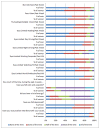Patient reported differences in dry eye disease between men and women: impact, management, and patient satisfaction
- PMID: 24098772
- PMCID: PMC3786885
- DOI: 10.1371/journal.pone.0076121
Patient reported differences in dry eye disease between men and women: impact, management, and patient satisfaction
Abstract
Purpose: Dry eye disease affects women twice as often as men, but there is little information on whether dry eye treatments, treatment satisfaction, or the impact of dry eye disease on patients' lives and vision might differ by sex.
Design: Questionnaire survey of 4000 participants in the Women's Health Study and the Physicians' Health Studies I and II with a prior report of a diagnosis of DED.
Methods: Among participants who re-confirmed a diagnosis of dry eye disease, we assessed symptoms, treatments, patient satisfaction and impact of dry eye disease, and analyzed differences between men and women using regression models.
Results: The final study population consisted of 1,518 women (mean age 70.7 years) and 581 men (mean age 76.7 years), with a mean reported duration of dry eye disease of 10.5 years and 10.1 years, respectively. The frequency and severity of dry eye disease symptoms were higher among women (each P<0.0001), and women reported a greater impact on everyday activities (P<0.0001). Women were more likely to use artificial tears (P<0.0001) use them more often (P<0.0001), and to use Restasis® (P<0.0001), omega-3 fatty acids (P=0.0006), and have punctal occlusion (P=0.005). Women spent more money per month on dry eye treatments (P<0.0001), but reported greater dissatisfaction with treatment side effects (P=0.001), and the amount of time before treatments started working (P=0.03).
Conclusions: These data show that dry eye disease is generally experienced as being more severe among women, having a greater impact on their self-assessed well-being.
Conflict of interest statement
Figures



References
-
- Definition and Classification Subcommittee of the International Dry Eye WorkShop (2007) The definition and classification of dry eye disease: report of the Definition and Classification Subcommittee of the International Dry Eye WorkShop. Ocul Surf 5: 75-92. - PubMed
-
- Epidemiology Subcommittee of the International Dry Eye WorkShop (2007) The epidemiology of dry eye disease: report of the Epidemiology Subcommittee of the International Dry Eye WorkShop. Ocul Surf 5: 93-107. - PubMed
-
- Management and Therapy Subcommittee of the International Dry Eye WorkShop (2007) Management and therapy of dry eye disease: report of the Management and Therapy Subcommittee of the International Dry Eye WorkShop. Ocul Surf 5: 163-178. - PubMed
-
- Miljanović B, Dana R, Sullivan DA, Schaumberg DA (2007) Impact of dry eye syndrome on vision-related quality of life. Am J Ophthalmol 143: 409-415. doi:10.1016/j.ajo.2006.11.060. PubMed: 17317388. - DOI - PMC - PubMed
Publication types
MeSH terms
Grants and funding
LinkOut - more resources
Full Text Sources
Other Literature Sources

